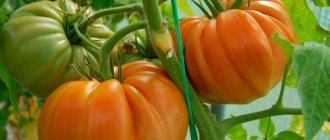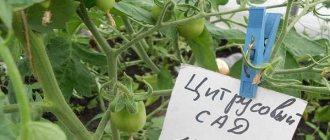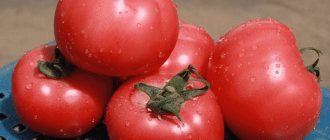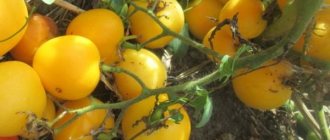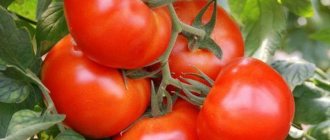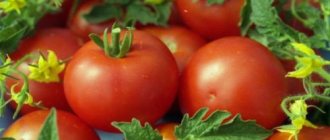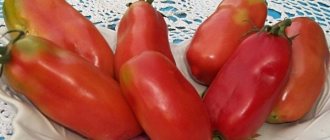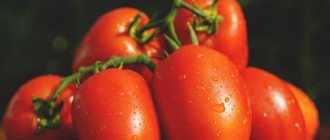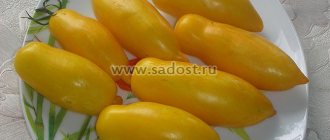Taste qualities of fruits
The Eternal Call tomato, reviews and photos of its yields can be seen on gardener forums, is also distinguished by its taste. Bright crimson fruits can be characterized as follows:
- fleshy;
- the texture of the pulp is sugary, tender;
- flat polished tomato;
- the average weight ranges from 500 to 600 g, but there are fruits weighing more than 900 grams;
- for preparations they are used only as components for salads and preserves, which provide for processing of the fruit.
Most often, the Eternal Call tomato is used fresh.
Planting and care
Sow seedlings in March, 55-60 days before the intended planting. For seeds, a mixture of garden soil, humus and river sand is suitable. The boxes with seeds are covered with film and put in a warm place where the temperature is maintained at +25 °C. After a week, the first shoots appear, which need to be provided with 14-hour daylight, the temperature is lowered to 20 °C. Picking in the phase of 1-2 true leaves.
Plants are planted in open beds when the threat of night frosts has passed. It is better to plant under temporary shelters, which can be easily removed in the future. The ground around the bushes is mulched with grass or agrospan. If there is no mulch layer, regular loosening and weeding are needed, and watering becomes more frequent in dry times.
Despite their low growth, the bushes, formed into 2-3 stems, are spreading, so it is important to tie them up in time. The stem cannot support the weight of large fruits; in some cases, each cluster is tied up
Tomatoes need to be pruned periodically.
Pros and cons of the tomato variety Eternal Call
Each variety of tomato has its own advantages and disadvantages. The positive qualities of tomato include the following:
- The fruits of the variety are large and have high taste characteristics;
- the ability to grow tomatoes in the northern regions of the country, since they are frost-resistant and manage to ripen in a short period of time;
- productivity is high;
- there is the possibility of long-term transportation (when collecting unripe fruits).
Tomatoes also have some disadvantages:
- tomatoes cannot be salted or pickled, as they simply will not fit in the jar;
- Gardeners note the fact that the most delicious fruits are obtained only when harvesting the first harvest. Subsequently, the tomatoes become less juicy and sweet.
Despite the small number of shortcomings, summer residents appreciated the Eternal Call variety. Since land owners often purchase several varieties of tomatoes for different purposes, Eternal Call must be included in the number of plantings.
Characteristics and description of the tomato variety
Tomato Eternal Call belongs to the determinant type of plants. A mid-season variety with high yield. The crop is grown in greenhouses and open ground.
The bushes are massive, spreading, reaching a height of 70 cm . They need strong support and support. When plants are formed into 2-3 stems, it is possible to collect a good harvest of large fruits. Vegetable growers harvest up to 370 kg of crop from one hundred square meters. The first fruits are harvested after 110–120 days.
The leaves are medium, dark emerald. The peduncle is without articulations, the inflorescence is simple.
Advantages and disadvantages of the variety
Virtues of the Eternal Call:
- excellent taste of large fruits;
- high productivity;
- long shelf life (40–45 days in a cool, dark place);
- ease of care;
- good transportability (when collecting unripe fruits);
- possibility of cultivation in regions with a cool climate: the variety is frost-resistant, the fruits ripen in a short time.
The variety also has disadvantages:
- tomatoes are not used for preservation, since large fruits do not fit in a jar;
- the culture needs gartering and pinching.
Some vegetable growers note that when they are first picked, tomatoes are more tasty, and later they are not so sweet and juicy.
Fruit characteristics and yield
The raspberry-colored fruits have 4 seed chambers .
Tomatoes are fleshy, sugary and have a delicate taste. They are eaten fresh and processed into juices and tomato paste. The fruits are not suitable for winter harvesting due to their large size. Vegetables tolerate transportation well without loss of taste and product characteristics. The shape of the tomatoes is flat with slight ribbing . The average weight is 500 g, but there are vegetables up to 900 g. From 3 to 5 kg of crop is harvested from one bush (for a low-growing variety this is a decent figure). In a greenhouse, the crop grows higher than in an open area, and more crops are harvested.
Which regions are best to grow in?
In the south of the country (in the Stavropol and Krasnodar territories, Volgograd region) the variety is grown in open areas, in shaded areas.
In central Russia (Yaroslavl, Bryansk regions, Moscow region and other regions), Eternal Call is cultivated in closed and open ground. In the north of the country (in Vologda, Altai and other regions), tomatoes are grown in greenhouses or greenhouses.
TOMATO ETERNAL CALL. TASTING. Olga Chernova.
Growing tomatoes Eternal Call
The tomato variety Eternal Call, the description of which speaks of its multiple advantages, does not require a special approach to cultivation. The tomato is distinguished by its unpretentiousness, and you don’t have to put a lot of effort into harvesting a good harvest.
Landing rules
Seeds are planted in the soil approximately 60 - 70 days before the planned planting of seedlings in the ground. The substrate can be purchased ready-made or mixed with the following components:
- garden soil – 4 parts;
- humus - 4 parts;
- sand (preferably coarse river sand) – 1.5 parts.
The seeds are sown in the ground, lightly sprinkled with soil so that the surface layer does not exceed 3 mm. The soil is moistened using a spray bottle so that the tomato seeds do not scatter in different directions.
The main condition for the successful growth of seedlings is the presence of light and compliance with a temperature regime of at least 23 oC.
Important! After diving, the Eternal Call tomato can grow in cooler conditions - from 18 to 20 oC.
Watering and fertilizing
Moderate but regular watering is also a prerequisite for growing tomatoes. It is best to use warm water that has had time to settle for these purposes. You cannot water from a watering can; it is better to use a sprayer.
Important! Excessive amounts of moisture can lead to acidification of the soil and rotting of seedlings.
Feeding the plant should be carried out only after diving. The first fertilizer can be applied two weeks after the seedlings are planted. In the future, the tomatoes can be fed 2-3 more times.
As a fertilizer, it is necessary to use special products, diluting them strictly according to the instructions.
Pinching and tying
Since the Eternal Call variety differs in the size of its fruits, the bushes of the plant need to be tied up or pinched. A sufficient amount of harvest can be provided by 3 main shoots, so the bush does not need other branches.
Attention! Tomatoes must be tied to wooden stakes.
Formation
Tomatoes require special conditions during fruit formation.
- Watering. During the period of flowering and fruit set, the plant needs an increased amount of moisture, so watering should be done more often. Experienced summer residents advise irrigating the soil coupled with fertilizing.
- Fertilizer. The first feeding should be done 14 days after cropping the tomatoes. You should use organic mixes containing minerals, or mullein diluted in water with superphosphate. In the future, you can use dry fertilizer. For each square meter you need:
- 3 parts superphosphate;
- 1.5 parts ammonium nitrate;
- 2 parts potassium salt.
The mixture of these components must be homogeneous so as not to harm the plant when applying fertilizer to the soil.
Protection from diseases and pests
From the description of the tomato variety Eternal Call, it is clear that the crop is highly resistant to diseases and pests, but despite this, it also needs protection from environmental influences. High yields can be achieved only with timely detection of diseases and pests:
- Blossom rot is a black or brown crust on the top of a tomato. Can be observed on unripe fruits with insufficient calcium. A solution of calcium nitrate, which is sprayed on the plant, can eliminate the problem.
- Whiteflies are white flies that can be found on the lower parts of foliage. Pests appear if the tomato grows in a greenhouse. The problem can be eliminated by ventilating the plant.
- Fusarium wilt of tomatoes is a disease of fungal origin. The plant looks as if it lacks moisture, the leaves at the bottom begin to turn yellow, the stem cracks and becomes covered with a black crust. Since infection can only enter through the root system, it is important to observe crop rotation or use products such as Trichodermin and Previkur.
- Gray rot affects tomatoes growing in greenhouses. The stems and leaves are most affected, but the fungus can also spread to the fruit. Ventilating the greenhouse will help get rid of dark spots with a gray tint.
- Leaf curl is a fungal disease that can affect a plant at various stages of its life. Control measures include fertilizing with microelements.
- Spider mites are small pests that damage plant foliage. As a result, you may find vegetation affected by yellow spots, which will die if appropriate measures are not taken. It is recommended to use biological products, for example, Actofit.
- Aphids are a pest that can destroy plants both in greenhouses and in open areas. Various means can cope with aphids - ashes, herbal decoctions (chamomile, yarrow), dust and others.
- Late blight - yellowing of leaves and their drying out, followed by transfer to the fruits. The main source of infection is damp soil. To avoid the death of tomatoes, it is necessary to observe the watering regime and crop rotation. Among the preparations for the Eternal Call, you can use Mikosan, Tattu, Quadris and others.
Despite the many possible diseases, the risk of their development can be reduced if you follow the rules of watering and timely, and most importantly, properly fertilize the plants.
Planting and care
Planting begins in mid-March. Sowing lasts until mid-April.
Tomato seeds have good germination. Before sowing, it is recommended to treat with 1% potassium permanganate. Then soak in activators to speed up germination. Popular products used include “Kornevin” and “Agate”.
What activities include caring for seedlings:
- Irrigation with warm water using a strainer or spray bottle.
- Feeding before and after picking with “Strong”.
- Hardening 1 week before transplanting to a permanent place.
- Lighting with special LED lamps so that the total daylight hours are at least 14 hours.
Recommended tomato varieties
Pretty guy User rating: 4/5
Unbreakable crimson User rating: 5/5
Eternal Call User rating: 5/5
Agata User rating: 5/5
Planting seedlings and caring for tomatoes
In order for tomatoes to produce high yields, no more than 2 to 3 seedlings are planted per square meter of area, which will give the bushes enough space. The soil around each plant is cultivated every 9-10 days, pre-watering. The soil can be any, but black soil or soil pre-mixed with humus is better. The main thing is looseness and good breathability. The planting pattern is 40 by 50 cm between bushes. Be sure to carry out pinching, leaving no more than 3 side shoots on the bush.
It is better if cucumbers or parsley, zucchini and cauliflower, and carrots grew earlier in the area where tomatoes are planted. It is recommended to water tomatoes after sunset or in the morning in cloudy weather - this will save the plant from water getting on the greens and sunburn. At the very beginning of the growth of tomatoes, watering should be regular, moderate, and as they flower and bear fruit - abundantly.
As experienced gardeners note, it is better to combine watering with fertilizing, but this is not necessary. Tomatoes are fed for the first time 2 weeks after planting seedlings in open ground - this can be organic fertilizers or organic compounds with a high percentage of mineral compounds.
It is optimal if the first feeding is a mixture of mullein and superphosphates in a ratio of 8:1. Dilute the composition in water. Subsequent feedings should be dry. The composition is as follows: per square meter of soil take ammonium nitrate, superphosphate and potassium salt in a ratio of 1:2:1.5.
Most often, tomatoes of the Eternal Call variety are affected by late blight. With timely treatment of the bed, the disease can be prevented. It is enough to treat the tomatoes with a 1% solution of Bordeaux mixture before planting seedlings and 2 weeks later. Tomatoes of this variety are quite resistant to parasites and pathogenic microorganisms.
Errors during cultivation
In the south, beds for this tomato are laid out in shaded areas, but in central Russia you need to choose well-lit places. Vegetable growers who grew the Eternal Call variety in the shade received sour fruits.
Tatyana Orlova (Vasilidchenko) (candidate of agricultural sciences):
Tomato has increased requirements for lighting. Nowhere, even in the south in hot regions, are tomatoes planted in the shade. To protect fruits from the sun in the south, varieties with well-developed large leaves are chosen. Balanced feeding with fertilizers helps to achieve their intensive growth. In small areas, on the hottest days, tomatoes are covered with white non-woven material, which is then removed as cloudiness increases.
Do not neglect the garter of bushes, relying on their determinant type. Due to the gravity, large tomatoes fall to the ground. They can deteriorate, attract pests, and be susceptible to disease.
According to the description of gardeners who grew the variety without forming bushes, the yield barely reached 2.5 kg, and the fruits grew smaller.
